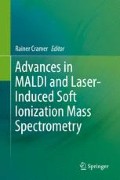Abstract
This chapter details a newly developed MALDI method which allows the generation of multiply charged ions of peptides and proteins similar to those produced by electrospray ionization (ESI) with high sensitivity and low sample consumption. A straightforward modification of a commercially available mass spectrometer with an atmospheric pressure (AP) ion source, and the necessary MALDI sample preparation protocol are described. This new method allows the combination of MALDI with mass analyzers of limited m/z range (e.g., quadrupoles, ion traps) for MS analysis of large biomolecules and ETD/ECD fragmentation for enhanced MS/MS analyses. In combination with ion mobility spectrometry (IMS) the signal-to-noise ratio of the multiply charged analyte ions can be significantly increased by filtering out the singly charged MALDI chemical noise ions.
Access this chapter
Tax calculation will be finalised at checkout
Purchases are for personal use only
Notes
- 1.
Note that any instrument modification and development work (including defeating interlocks and setting up lasers) will have Health and Safety implications and can invalidate the warranty and certain service/maintenance contracts for commercial instrumentation. For the former, please consult your local Health and Safety officer and the pertinent local rules and regulations.
- 2.
Note that other UV lasers have been successfully used (e.g., Cramer et al. 2013).
- 3.
The sample remains liquid under ambient conditions for weeks using this sample preparation protocol. For the DHB-based sample preparation, it was observed that for relatively high amounts of analyte (e.g., 5 pmol on target) the deposited sample may be used for at least 2 weeks, providing good analyte signal.
- 4.
For this the MALDI target plate was coated with a saturated solution of CHCA in acetone, which immediately dries, leaving a thin layer of CHCA crystals behind. The thin film was then irradiated by the laser at the maximum energy for a sufficiently long period of time, making sure that the matrix on this spot was completely ablated. The size of the ablation spot was then measured under a microscope.
References
Angel PM, Caprioli RM (2012) Matrix-assisted laser desorption ionization imaging mass spectrometry: in situ molecular mapping. Biochemistry 52(22):3818–3828. doi:10.1021/bi301519p
Bahr U, Deppe A, Karas M et al (1992) Mass spectrometry of synthetic polymers by UV-matrix-assisted laser desorption/ionization. Anal Chem 64(22):2866–2869. doi:10.1021/ac00046a036
Cramer R, Corless S (2001) The nature of collision-induced dissociation processes of doubly protonated peptides: comparative study for the future use of matrix-assisted laser desorption/ionization on a hybrid quadrupole time-of-flight mass spectrometer in proteomics. Rapid Commun Mass Spectrom 15(22):2058–2066. doi:10.1002/rcm.485
Cramer R, Corless S (2005) Liquid ultraviolet matrix-assisted laser desorption/ionization—mass spectrometry for automated proteomic analysis. Proteomics 5(2):360–370. doi:10.1002/pmic.200400956
Cramer R, Pirkl A, Hillenkamp F, Dreisewerd K (2013) Liquid AP-UV-MALDI enables stable ion yields of multiply charged peptide and protein ions for sensitive analysis by mass spectrometry. Angew Chem Int Ed Engl 52(8):2364–2367. doi:10.1002/anie.201208628
Fenn JB, Mann M, Meng CK et al (1989) Electrospray ionization for mass spectrometry of large biomolecules. Science 246(4926):64–71
Fournier P-E, Drancourt M, Colson P et al (2013) Modern clinical microbiology: new challenges and solutions. Nat Rev Microbiol 11(8):574–585. doi:10.1038/nrmicro3068
Frankevich V, Zhang J, Dashtiev M, Zenobi R (2003) Production and fragmentation of multiply charged ions in ‘electron-free’ matrix-assisted laser desorption/ionization. Rapid Commun Mass Spectrom 17(20):2343–2348. doi:10.1002/rcm.1194
Good DM, Wirtala M, McAlister GC, Coon JJ (2007) Performance characteristics of electron transfer dissociation mass spectrometry. Mol Cell Proteomics 6(11):1942–1951. doi:10.1074/mcp.M700073-MCP200
Huang Y, Triscari JM, Tseng GC et al (2005) Statistical characterization of the charge state and residue dependence of low-energy CID peptide dissociation patterns. Anal Chem 77(18):5800–5813. doi:10.1021/ac0480949
Karas M, Hillenkamp F (1988) Laser desorption ionization of proteins with molecular masses exceeding 10,000 daltons. Anal Chem 60(20):2299–2301. doi:10.1021/ac00171a028
Karas M, Bachmann D, Bahr U, Hillenkamp F (1987) Matrix-assisted ultraviolet laser desorption of non-volatile compounds. Int J Mass Spectrom Ion Process 78:53–68. doi:10.1016/0168-1176(87)87041-6
Köfeler HC, Fauland A, Rechberger GN, Trötzmüller M (2012) Mass spectrometry based lipidomics: an overview of technological platforms. Metabolites 2(4):19–38. doi:10.3390/metabo2010019
König S, Kollas O, Dreisewerd K (2007) Generation of highly charged peptide and protein ions by atmospheric pressure matrix-assisted infrared laser desorption/ionization ion trap mass spectrometry. Anal Chem 79(14):5484–5488. doi:10.1021/ac070628t
Kononikhin A, Nikolaev E, Frankevich V, Zenobi R (2005) Letter: multiply charged ions in matrix-assisted laser desorption/ionization generated from electrosprayed sample layers. Eur J Mass Spectrom 11(1):257–259. doi:10.1255/ejms.729
Makarov A (2000) Electrostatic axially harmonic orbital trapping: a high-performance technique of mass analysis. Anal Chem 72(6):1156–1162. doi:10.1021/ac991131p
Marshall AG, Hendrickson CL, Jackson GS (1998) Fourier transform ion cyclotron resonance mass spectrometry: a primer. Mass Spectrom Rev 17(1):1–35. doi:10.1002/(SICI)1098-2787(1998)17:1<1::AID-MAS1>3.0.CO;2-K
Palmblad M, Cramer R (2007) Liquid matrix deposition on conductive hydrophobic surfaces for tuning and quantitation in UV-MALDI mass spectrometry. J Am Soc Mass Spectrom 18(4):693–697. doi:10.1016/j.jasms.2006.11.013
Tanaka K, Waki H, Ido Y et al (1988) Protein and polymer analyses up to m/z 100,000 by laser ionization time-of-flight mass spectrometry. Rapid Commun Mass Spectrom 2(8):151–153. doi:10.1002/rcm.1290020802
Towers M, Cramer R (2007) Liquid matrices for analyses by UV-MALDI mass spectrometry. Spectroscopy 22(11):29–37
Trimpin S, Inutan ED, Herath TN, McEwen CN (2010) Laserspray ionization, a new atmospheric pressure MALDI method for producing highly charged gas-phase ions of peptides and proteins directly from solid solutions. Mol Cell Proteomics 9(2):362–367. doi:10.1074/mcp.M900527-MCP200
Xian F, Hendrickson CL, Marshall AG (2012) High resolution mass spectrometry. Anal Chem 84(2):708–719. doi:10.1021/ac203191t
Acknowledgement
This work is supported by the EPSRC through grant EP/L006227/1.
Author information
Authors and Affiliations
Corresponding author
Editor information
Editors and Affiliations
Rights and permissions
Copyright information
© 2016 Springer International Publishing Switzerland
About this chapter
Cite this chapter
Ryumin, P., Cramer, R. (2016). Efficient Production of Multiply Charged MALDI Ions. In: Cramer, R. (eds) Advances in MALDI and Laser-Induced Soft Ionization Mass Spectrometry. Springer, Cham. https://doi.org/10.1007/978-3-319-04819-2_2
Download citation
DOI: https://doi.org/10.1007/978-3-319-04819-2_2
Publisher Name: Springer, Cham
Print ISBN: 978-3-319-04818-5
Online ISBN: 978-3-319-04819-2
eBook Packages: Biomedical and Life SciencesBiomedical and Life Sciences (R0)

